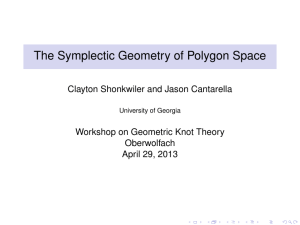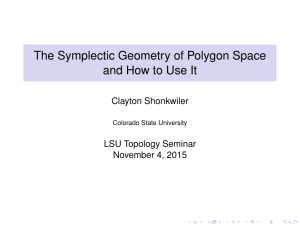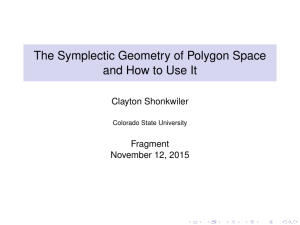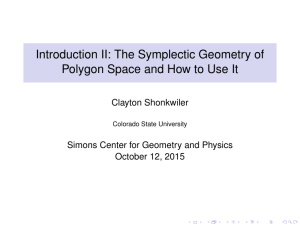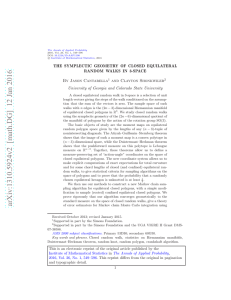The Symplectic Geometry of Polygon Space
advertisement
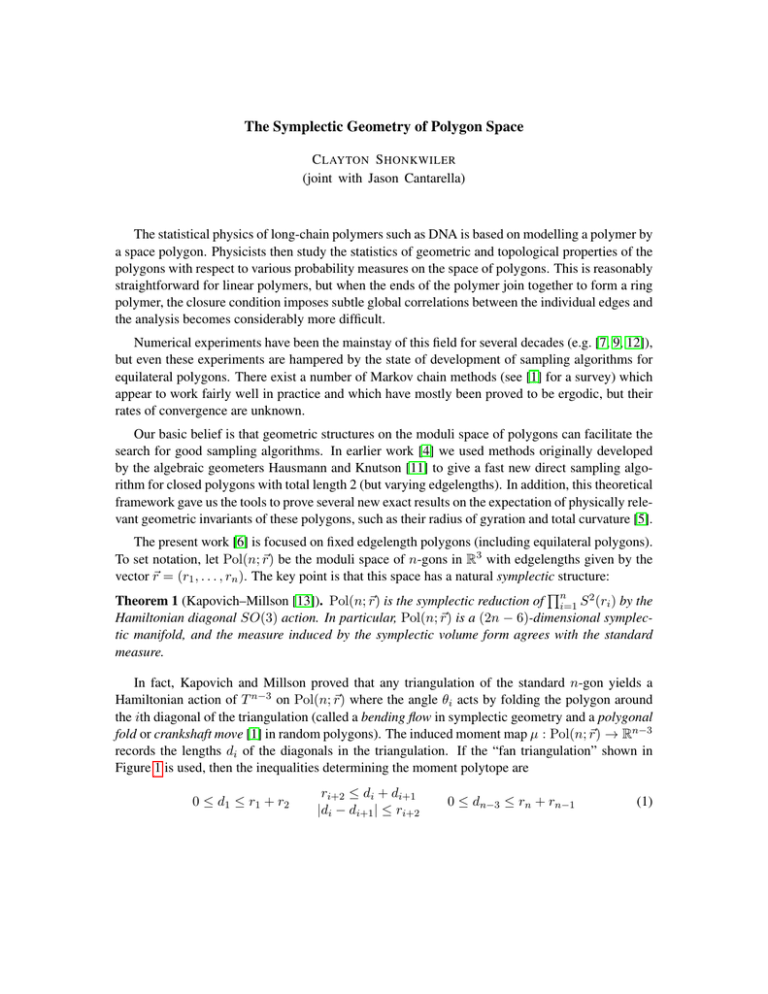
The Symplectic Geometry of Polygon Space C LAYTON S HONKWILER (joint with Jason Cantarella) The statistical physics of long-chain polymers such as DNA is based on modelling a polymer by a space polygon. Physicists then study the statistics of geometric and topological properties of the polygons with respect to various probability measures on the space of polygons. This is reasonably straightforward for linear polymers, but when the ends of the polymer join together to form a ring polymer, the closure condition imposes subtle global correlations between the individual edges and the analysis becomes considerably more difficult. Numerical experiments have been the mainstay of this field for several decades (e.g. [7, 9, 12]), but even these experiments are hampered by the state of development of sampling algorithms for equilateral polygons. There exist a number of Markov chain methods (see [1] for a survey) which appear to work fairly well in practice and which have mostly been proved to be ergodic, but their rates of convergence are unknown. Our basic belief is that geometric structures on the moduli space of polygons can facilitate the search for good sampling algorithms. In earlier work [4] we used methods originally developed by the algebraic geometers Hausmann and Knutson [11] to give a fast new direct sampling algorithm for closed polygons with total length 2 (but varying edgelengths). In addition, this theoretical framework gave us the tools to prove several new exact results on the expectation of physically relevant geometric invariants of these polygons, such as their radius of gyration and total curvature [5]. The present work [6] is focused on fixed edgelength polygons (including equilateral polygons). To set notation, let Pol(n; ~r) be the moduli space of n-gons in R3 with edgelengths given by the vector ~r = (r1 , . . . , rn ). The key point is that this space has a natural symplectic structure: Q Theorem 1 (Kapovich–Millson [13]). Pol(n; ~r) is the symplectic reduction of ni=1 S 2 (ri ) by the Hamiltonian diagonal SO(3) action. In particular, Pol(n; ~r) is a (2n − 6)-dimensional symplectic manifold, and the measure induced by the symplectic volume form agrees with the standard measure. In fact, Kapovich and Millson proved that any triangulation of the standard n-gon yields a Hamiltonian action of T n−3 on Pol(n; ~r) where the angle θi acts by folding the polygon around the ith diagonal of the triangulation (called a bending flow in symplectic geometry and a polygonal fold or crankshaft move [1] in random polygons). The induced moment map µ : Pol(n; ~r) → Rn−3 records the lengths di of the diagonals in the triangulation. If the “fan triangulation” shown in Figure 1 is used, then the inequalities determining the moment polytope are 0 ≤ d1 ≤ r1 + r2 ri+2 ≤ di + di+1 |di − di+1 | ≤ ri+2 0 ≤ dn−3 ≤ rn + rn−1 (1) 2 FIG. 1: The fan triangulation of a polygon The image of the moment map is a convex polytope called the moment polytope [3, 10]. Since the torus is half-dimensional (and hence the manifold is toric), the Duistermaat–Heckman theorem [8] implies that the pushforward of the symplectic measure on Pol(n; ~r) to the moment polytope is a constant multiple of Lebesgue measure. We can now give a strategy for sampling fixed edgelength polygons. In general, when M 2n is a toric manifold with moment polytope P such that the moment map can be inverted, we can construct a map α : P × T n → M which parametrizes a full-measure subset of M by “actionangle” coordinates. Moreover, this map is measure-preserving. Therefore, a general procedure for sampling a toric symplectic manifold uniformly with respect to its symplectic measure is to sample P and T n independently and uniformly. In particular, since the symplectic measure and the standard measure agree on Pol(n; ~r), we have Theorem 2 (with Cantarella [6]). Polygons in Pol(n; ~r) are sampled according to the standard measure if and only if the diagonal lengths d1 , . . . , dn−3 are uniformly sampled from the moment polytope defined by the inequalities (1) and the dihedral angles θ1 , . . . , θn−3 are sampled independently and uniformly in [0, 2π). Note that these uniformity conditions give concrete criteria for evaluating the quality of any polygon sampling algorithm. Since a polygon P ∈ Pol(n; ~1) is in rooted spherical confinement of radius r if each diagonal length di ≤ r, the moment polytope for rooted sphere-confined polygons is determined by the inequalities (1) plus the additional inequalities di ≤ r for all i. Thus, Theorem 2 easily extends to the case of confined polygons. For small n the moment polytope can be sampled directly by decomposing it into standard simplices. For large n direct sampling seems challenging, but the moment polytope can certainly be sampled using the hit-and-run algorithm [2], which is a Markov chain algorithm known to produce approximately uniformly distributed sample points on arbitrary convex polytopes in Rm in time O∗ (m3 ) [14]. In particular, we can sample fixed edgelength n-gons in any chosen confinement by generating points in the (n − 3)-dimensional moment polytope using hit-and-run and then pairing each point with n − 3 independent uniform dihedral angles. Figure 2 shows two equilateral 100gons (not to scale) sampled using this algorithm. To close, here are two open questions whose answers would give significant insight into the space of fixed edgelength polygons: 3 Unconfined 100-gon 1.1-confined 100-gon FIG. 2: Two equilateral 100-gons with all edgelengths equal to 1. The 100-gon on the left is completely unconfined, while the 100-gon on the right is confined to a sphere of radius 1.1. 1. Can the volume of the space of confined polygons be bounded below? If so, this should give lower bounds on the probability of complicated knots, since such knots will almost certainly be highly confined. 2. Is there a combinatorial description of the fan triangulation polytope (e.g. a simplicial decomposition)? Such a description would give a direct sampling algorithm for fixed edgelength polygons. [1] Sotero Alvarado, Jorge Alberto Calvo, and Kenneth C Millett. The generation of random equilateral polygons. Journal of Statistical Physics, 143(1):102–138, 2011. [2] Hans C Andersen and Persi W Diaconis. Hit and run as a unifying device. Journal de la Société Française de Statistique, 148(4):5–28, 2007. [3] Michael F Atiyah. Convexity and commuting Hamiltonians. Bulletin of the London Mathematical Society, 14(1):1–15, 1982. [4] Jason Cantarella, Tetsuo Deguchi, and Clayton Shonkwiler. Probability theory of random polygons from the quaternionic viewpoint. Communications on Pure and Applied Mathematics, 2013. To appear. arXiv:1206.3161 [math.DG]. [5] Jason Cantarella, Alexander Y Grosberg, Robert Kusner, and Clayton Shonkwiler. Expected total curvature of random polygons. Preprint, arXiv:1210.6537 [math.DG], 2012. [6] Jason Cantarella and Clayton Shonkwiler. Symplectic methods for random equilateral polygons and the moment polytope sampling algorithm. In preparation, 2013. [7] Tetsuo Deguchi and Kyoichi Tsurusaki. Topology of closed random polygons. Journal of the Physics Society Japan, 62(5):1411–1414, 1993. [8] Johannes J Duistermaat and Gerrit J Heckman. On the variation in the cohomology of the symplectic form of the reduced phase space. Inventiones Mathematicae, 69(2):259–268, 1982. [9] Maxim D Frank-Kamenetskii, Alexander V Lukashin, and Alexander V Vologodskii. Statistical mechanics and topology of polymer chains. Nature, 258(5534):398–402, 1975. [10] Victor Guillemin and Shlomo Sternberg. Convexity properties of the moment mapping. Inventiones Mathematicae, 67(3):491–513, 1982. [11] Jean-Claude Hausmann and Allen Knutson. Polygon spaces and Grassmannians. L’Enseignement Mathématique. Revue Internationale. 2e Série, 43(1-2):173–198, 1997. 4 [12] E J Janse van Rensburg and Stuart G Whittington. The knot probability in lattice polygons. Journal of Physics A: Mathematical and General, 23(15):3573–3590, 1999. [13] Michael Kapovich and John J Millson. The symplectic geometry of polygons in Euclidean space. Journal of Differential Geometry, 44(3):479–513, 1996. [14] László Lovász. Hit-and-run mixes fast. Mathematical Programming. A Publication of the Mathematical Programming Society, 86(3, Ser. A):443–461, 1999.






